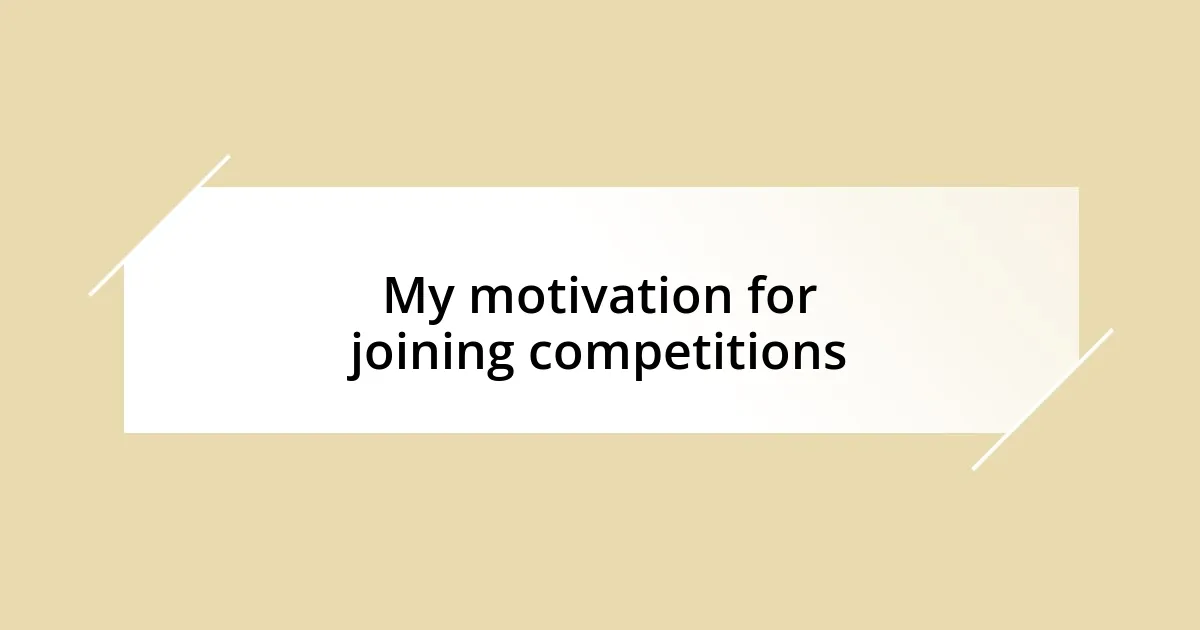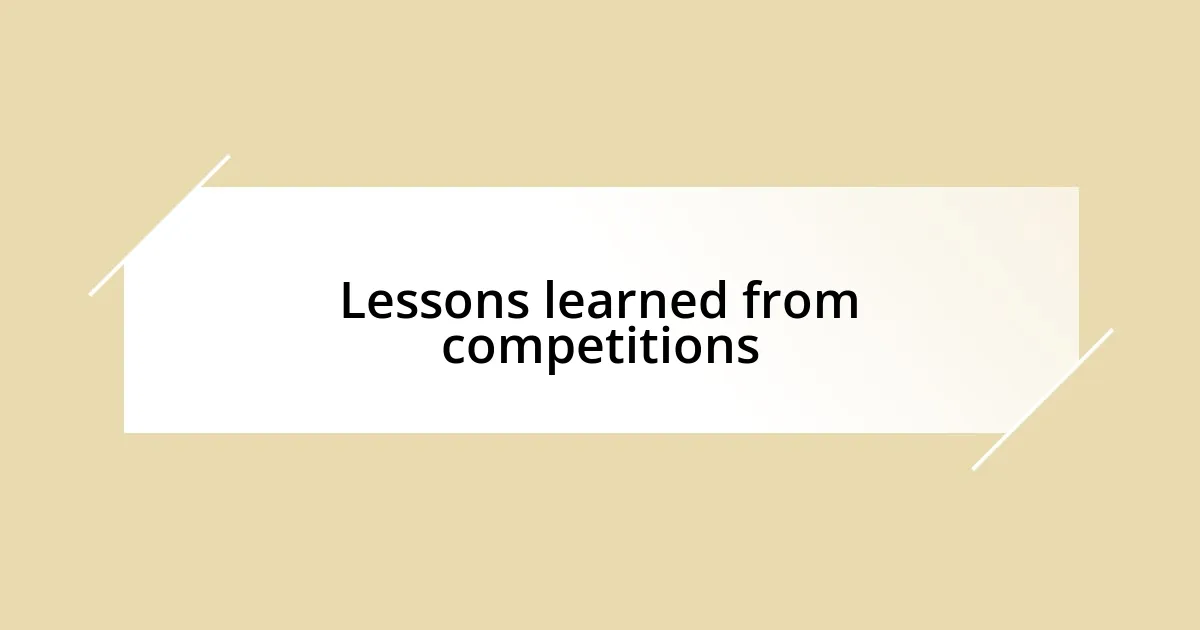Key takeaways:
- Building my first robot sparked a passion for innovation, teamwork, and resilience in competitions.
- Effective teamwork relies on shared goals, open communication, and celebrating small achievements.
- Challenges faced during competitions taught me the importance of adaptability and learning from setbacks.
- Strong relationships with teammates enhance the journey, making challenges and victories more meaningful.

My motivation for joining competitions
From the moment I built my first robot in high school, I was hooked. The thrill of seeing it move for the first time overwhelmed me with excitement. But what really drove me was the opportunity to innovate and solve real problems; every competition was a chance to push the boundaries of my creativity and understanding.
I remember one specific competition where our team faced an unexpected technical failure right before our turn. The panic was palpable, but instead of giving up, we rallied together, thinking of last-minute fixes and strategizing on the fly. That experience taught me the value of teamwork and resilience, which ignited a deeper passion for competitions—it’s not just about winning; it’s about learning and growing through challenges.
Have you ever felt a rush when you accomplish something you once thought was impossible? That feeling motivated me to keep joining competitions. Each event became a personal journey, a blend of stress, thrill, and fulfillment. I realized that every competition was not just a test of my technical skills, but an exploration of my limits and an opportunity to discover what I could truly achieve.

Key skills gained from robotics
When it comes to robotics competitions, I’ve come to appreciate that the skills gained extend far beyond just technical know-how. Each event is a treasure trove of learning experiences, honing my ability to think critically and adapt swiftly. There was one moment during a regional competition when our programming code malfunctioned during the final round. With only minutes left, I had to quickly debug our robot while my teammates focused on recalibrating the sensors. That urgency sharpened my problem-solving skills, showing me the importance of staying calm under pressure and thinking on my feet.
Here are some key skills I’ve gained from my journey in robotics competitions:
- Teamwork: Collaborating with others to achieve a common goal, learning to communicate effectively in high-stress situations.
- Problem Solving: Navigating unexpected challenges, requiring quick thinking and innovative solutions.
- Technical Proficiency: Gaining hands-on experience with programming, engineering principles, and robotic design.
- Resilience: Learning to bounce back from failures and setbacks, embracing them as part of the learning process.
- Time Management: Balancing multiple tasks and deadlines in a competitive environment, enhancing my organization skills.
Each competition has molded not just my technical acumen but also my character, imbuing me with a sense of confidence that I carry into every new challenge.

Finding the right team
Finding the right team for robotic competitions is crucial, as it can significantly influence your experience and success. I once joined a group where my ideas were welcomed, and that excitement fueled our creative juices. Every brainstorming session felt like a collaboration of minds, where diverse viewpoints transformed a simple concept into something extraordinary.
In another instance, I faced a team that was skilled but lacked synergy. There was talent, but it was like a well-tuned orchestra playing different songs. The energy was chaotic rather than cohesive. Reflecting on this, I’ve learned that shared goals and communication are as vital as technical skills when seeking out a team. It’s not just about who can code or build; it’s about finding those who can inspire and uplift each other.
Ultimately, I believe that compatibility and enthusiasm are key to a fruitful team dynamic. The joy of collaborating with passionate individuals often outweighs even the podium finish. Have you ever felt a sense of belonging that drives performance? When I found a team that resonated with me, we didn’t just participate; we thrived, turning challenges into adventures along the way.
| Criteria | Team A (Ideal) | Team B (Chaotic) |
|---|---|---|
| Skill Level | Diverse and complementary | High individual skills |
| Communication | Open and supportive | Poor and fragmented |
| Shared Goals | Aligned and clear | Misaligned and conflicting |
| Team Spirit | Encouraging and motivating | Competitive and tense |

Preparing for the first competition
Preparing for my first robotics competition felt like stepping into a new world. I vividly recall the mix of excitement and anxiety that filled the air during our initial team meetings. We spent countless hours brainstorming ideas, sketching designs, and learning how to work together effectively. It was interesting to see how our individual skills began to blend into a cohesive strategy. I often wondered, “Can we really pull this off?” Each practice session answered that question in ways I never expected.
As competition day approached, our focus shifted from building to refining our robot. I can still picture the late nights spent in the workshop, debugging code and testing sensors until we got everything just right. There was this palpable sense of urgency as deadlines loomed, pushing us to optimize every aspect of our design. I felt a surge of determination each time we overcame a challenge. It wasn’t just about competing; it was about learning and growing together as a team.
One thing that truly stood out during preparation was the emotional rollercoaster we experienced. The thrill of small victories, like successfully completing a test run, often got overshadowed by moments of doubt when things didn’t go as planned. I learned to channel that uncertainty into motivation. I often caught myself thinking, “If we can solve this problem, we’ll be unstoppable.” And in that mindset, I discovered the essence of resilience—a quality that I now recognize as vital not only in robotics but in every facet of life.

Challenges faced during competitions
Every competition brings its own set of challenges, and I learned that firsthand during my robotic journey. One significant hurdle I faced was the inevitable technical difficulties that seemed to pop up out of nowhere. I remember during one event when our robot suddenly stopped responding right before our match. I felt a surge of panic, thinking, “What if all our hard work crumbles in front of everyone?” My heart raced as we scrambled to diagnose the issue, realizing that those moments of crisis often tested our teamwork just as much as the competition itself.
Another obstacle I often encountered was the intense pressure that came with competing. It wasn’t just about building a robot; it was about performing under a spotlight. I distinctly recall standing in the queue for our first match, feeling the sweat trickle down my back. I asked myself, “Can we really deliver what we promised?” This pressure could be suffocating, but it also pushed us to elevate our game, turning nerves into focus and adrenaline into energy.
Finally, the emotional ups and downs of competitions were something I didn’t quite expect. The elation of winning a round was thrilling but often followed by the sting of a surprising defeat. I vividly remember how after a tough loss, I had to remind myself that this was a learning experience. I thought, “What can I take from this to improve next time?” Embracing these setbacks helped shift my perspective, transforming challenges into valuable lessons that shaped my journey in robotics.

Strategies for effective teamwork
Effective teamwork is more than just dividing tasks; it’s about leveraging each member’s strengths. I recall a moment when our programmer and mechanical engineer stayed late to brainstorm how to integrate new features into the robot. Watching the two of them bounce ideas off each other was incredible. It made me realize that creating an environment where everyone feels comfortable sharing their thoughts can lead to innovative solutions we might have never considered.
Communication is another cornerstone of successful collaboration. During one session, we faced a misunderstanding about the robot’s design intent, which nearly derailed our progress. But we took a moment to regroup and held a team circle where everyone shared their thoughts. This openness wasn’t just a formality; it reinforced our bonds and clarified our goals. I often ask myself, “How can we make our communication even clearer?” In my experience, open dialogue not only resolves conflicts but also fosters camaraderie.
I also learned that celebrating small achievements can significantly boost morale. After executing a flawless test run, our whole team gathered for a quick high-five session. It seemed so simple, yet the energy shifted dramatically. Reflecting on these experiences, I’ve come to believe that recognizing progress, no matter how minor, cultivates a positive atmosphere—one that encourages ongoing effort and innovation, keeping the team motivated even during tough times.

Lessons learned from competitions
Competing taught me that every setback can be a stepping stone. I remember one competition where we faced an unexpected malfunction during our final match. Instead of feeling defeated, I asked myself, “What can we learn from this failure?” That moment ignited a drive within me to analyze our missteps deeply, turning frustration into a genuine desire for growth. It was a transformative experience, showcasing how adversity can lead to improvement.
Another valuable lesson was the importance of adaptability. During one event, our robot performed brilliantly during practice but faltered in the competition. It was frustrating, and I felt the weight of my teammates’ expectations. I quickly realized that flexibility is vital in robotics. I asked the team, “How can we adjust our strategies in real-time?” This prompted an immediate brainstorming session where we leveraged everyone’s insights, proving that our collective adaptability often became our greatest asset.
Lastly, I discovered that the relationships formed during competitions are just as vital as the skills acquired. After a particularly grueling day, I shared a pizza with my teammates, and we started reflecting on our journey. It hit me: these moments of camaraderie fueled our resilience. I genuinely believe that strong bonds not only make the challenges bearable but also amplify our successes—reminding us that in robotics, as in life, it’s not just about the victory; it’s about who we share the journey with.












